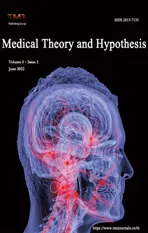Comprehensive analysis of the potential biological mechanism of Danggui Buxue Decoction in the treatment of Thalassemia
2022-06-28BeiJingDiZhangXinLiHuiMeiShiShiQuanChangYaChunZhengZhenNiChenGuoPingZhao
Bei Jing,Di Zhang,Xin Li,Hui-Mei Shi,Shi-Quan Chang,Ya-Chun Zheng,Zhen-Ni Chen,Guo-Ping Zhao*
1School of Traditional Chinese Medicine,Jinan University,Guangdong 510632,China.
Abstract Background: This study aimed to deeply explore the active components of Danggui Buxue Decoction (DBD) through systematic network pharmacology and molecular docking methods and to demonstrate its mechanism of regulating Thalassemia. Methods: Obtain and screen the active ingredients and targets of DBD from the TCMSP database.Use the GeneCards database to search for the gene corresponding to the target.The target protein-protein interaction (PPI) network was built using STRING database.A DBD-drug-Tha-target PPI network was established, and its core target network was analyzed using Cytoscape software.Then,enrichment analysis of DBD core targets was performed by Gene Ontology (GO) and Kyoto Encyclopedia of Genes and Genomes (KEGG), and their binding activities were verified by molecular docking. Results: Finally, 19 active ingredients and 504 targets were obtained from DBD, of which 98 targets were repeated with the related targets of Tha.The major genes include HSP90AA1,IL-6 and HRAS.Through the final analysis,we found that the main mechanisms of DBD in the treatment of thalassemia include increasing the expression of the γ-globin gene in red blood cells, inducing fetal hemoglobin and reducing the inflammatory response.Conclusion:The potential mechanism of DBD improving thalassemia can be preliminarily predicted by network pharmacology and molecular docking, which can provide some reference for clinical treatment.
Keywords:Danggui Buxue Decoction;Thalassemia;network pharmacology;Molecular docking
Background
Thalassemia (Tha) is an imbalance in the synthesis of the globin peptide chain caused by a deletion or mutation in the globin gene,resulting in a lack or deficiency in the synthesis of at least one of the globins in hemoglobin,ultimately resulting in anemia or hemolytic disease [1].Tha is one of the most common hereditary diseases in humans.It is a common disease in the Mediterranean region and is widely distributed in the Middle East and Southeast Asia.Millions of people around the world are affected by the disease [2].The disease is characterized by an unbalance in the ratio of alpha/beta protein chains, ineffective erythropoiesis, chronic hemolytic anemia, compensatory hematopoietic expansion, hypercoagulability and increased intestinal iron absorption [3].Typically, treatment is chosen based on the type and severity of the Mediterranean disease.Tha moderate to severe requires blood transfusions, iron chelation therapy, spleen or cholecystectomy, stem cell transplantation, or gene therapy [4].Blood transfusion can do its best to prolong and improve the life expectancy and quality of life of patients with β-tha, but long-term transfusion can cause iron overload in the body,resulting in a series of complications such as heart failure,liver disease, endocrine disorders and eventually death [5].Presently hematopoietic stem cell transplantation (HSCT) remains the only comprehensive treatment for this disease, but the clinical usage is severely limited by its high price and high risk[6].
Danggui Buxue Decoction(DBD)is a classic Chinese herbal formula in the ancient book of Chinese medicine "NeiWaiShangBianHuoLun"(Distinguishing the Confusion of Internal and External Injury;1231C.E.–1247C.E.) written by Li Dongyuan (1180–1251) in Song Dynasty (960–1279) in China.The ratio of Astragalus (Radix Astragali) to Angelica (Angelicae Sinensis Radix) is 5:1 [7].And it was recommended as fortifying"Qi"(Qi is considered to be the force that informs and animates all things in Daoism, which is believed to flow through the body along routes known as meridians; illness is attributed to changes in the flow of Qi according to the construct of Chinese medicine.) and blood tonic, DBD has been shown in several studies to have therapeutic interventions for several types of anemia[8–10].However,due to the complex chemical composition of the herbal compound, the comprehensive mechanism of how DBD improves Tha remains to be further elucidated.
In this study,we use network pharmacology and molecular docking as a tool to investigate the potential molecular mechanism of the DBD pair in the treatment of Tha, which provided new possibilities and directions for the treatment of Tha.The flow chart of this study can be obtained in Figure 1.

Figure 1 Flowchart of the comprehensive analysis of DBD in the treatment of Tha.
Methods
Collection of component targets of DBD
The TCMSP database (http://lsp.nwsuaf.edu.cn) is used to collect all the compounds in DBD,set the parameters as oral bioavailability(OB)≥30%and drug similarity (DL)≥0.18.Upload the CAS numbers of the collected compounds to the Pubchem platform (https://pubchem.ncbi.nlm.nih.gov/) to get its canonical SMILES structure format.Afterward, utilizing the Swiss Target Prediction platform (http://www.swisstargetprediction.ch/) to predict compounds-related targets;
The-prediction t of target genes involved in Tha
Relatedgenes to Tha were acquired from the GeneCards database.(https://www.genecards.org/) through searching "Thalassemia".Set species to "Homo sapiens", 1083 tha-related genes were identified in the GenBank database.The screened compounds and disease targets were introduced into the Venn platform (http://bioinformatics.psb.ugent.be/webtools/Venn/), and their common targets were identified as targets related to DBD and Tha and included in further analysis.
Drug-Component-Target network Construction
Using Cytoscape 3.8.2 software, the screened compounds and targets related to Tha were imported, and the Drug-Component-Target network was constructed.
Protein-protein Interaction(PPI)Data
These Tha-related targets were entered into STRING(http://string-DB.org/)to obtain a PPI map,and targets with a confidence value≥0.7 was as the final targets,and get the PPI network interaction diagram.
Gene Ontology (GO) and Kyoto Encyclopedia of Genes and Genome(KEGG)Analysis
Use DAVID (https://david.ncifcrf.gov/) database for GO and KEGG analysisof the screened targets.The top 10 GO and 20 KEGG pathway enrichment analysis results were visualized using histograms or bubble plots by bioinformatics (http://www.bioinformatics.com) and sangerbox(http://www.sangerbox.com).
Molecular docking
Download the crystal structure of the desired protein target from the RCSB Protein Data Bank (http://www.pdb.org/).Molecular docking was performed using AutodockTools Venn.During the docking process, the binding mode and affinity between DBD compound active molecules and target proteins were predicted by simulating ligand-receptor interactions(including electrostatic, hydrogen bonding, hydrophobic, van der Waals,etc.).The Pymol Win software visualizes the results and stores them in pdb format.
Results
Active Compounds of DBD, Tha Targets Prediction and Common Targets
Search the Genecards database website using "Thalassemia" as a keyword,1083 genes related to Tha were retrieved, At the same time, based on the TCMSP database,504 target genes related to DBD were collected.The Venn platform was used to analyze 17 compounds, 504 targets, and 1083 Tha-related targets obtained by DBD, and finally, 94 drug-disease target cross-target genes were obtained (Figure 2).Common targets may serve as potential therapeutic targets for DBD to improve Tha.
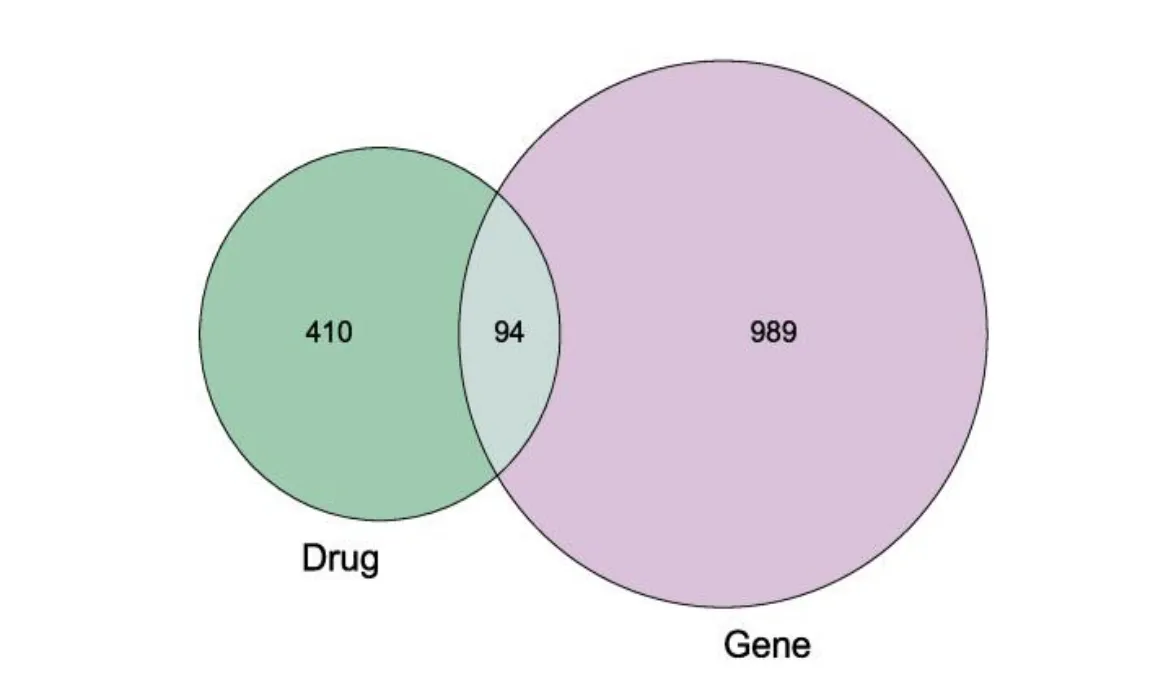
Figure 2 Venn diagram of the relationship between active ingredient targets and Tha-related targets in DBD.This figure shows that 94 targets were common to DBD(compound genes)and Tha(disease genes).
Drug-Component-Target network
After identifying the compound-disease-related target gene, we visualized the interaction network with 115 nodes (including 2 herbs, 19 compounds,and 94 genes) and 322 edges using Cytoscape 3.8.2 (Figure 3).Among 94 genes, According to the degree analysis, the top three compounds were quercetin, 3,9-di-O-methylnissolin and isoflavanone.Table 1 presents the details of the first three compounds.

Figure 3 Drug-compound-target network of DBD.Two herbal medicines and 19 compounds were predicted to have 94 common potential protein targets.The common-target network included 115nodes and 322 edges.The triangle nodes are composed of all the herbs of DBD, which are surrounded by their particular compounds.The circle nodes represent the compounds of DBD.The rhombus nodes, arranged into a circular matrix represent the relative gene targets of DBD.

Table 1:Basic information on the top three degrees of the compound
Construction of protein–protein interactions(PPI)network
To further explore the interesting association between DBD and Tha.Import 94 common target genes into STRING database to obtain an interaction network of 78 target proteins,and use Cytoscape 3.8.2 to build a PPI network diagram.HSP90AA1、IL-6 and HRAS(degree>15)were the top three most relevant targets.(Figure 4,Table 2).

Figure 4 The PPI network of 94 nodes (genes).PPI network of targets generated using STRING 11.5.Nodes represent proteins.Edges represent PPIs.The larger nodes represent more important hub nodes.The smaller nodes represent the other nodes.

Table 2:A partial information table for the core targets
GO and KEGG enrichment analysis
David database was used for enrichment analysis of DBD-improving Tha-related targets.In Biological Process (BP) analysis, the top ranked targets were distributed in the response to drug, positive regulation of cell proliferation, inflammatory response, response to lipopolysaccharide,positive regulation of ERK1 and ERK2 cascade, cellular response to hypoxia, negative regulation of gene expression, positive regulation of nitric oxide biosynthetic process, positive regulation of angiogenesis, positive regulation of peptidyl-tyrosine phosphorylation.Cellular Component (CC)analysis showed that cell components such as cytoplasm,plasma membrane,and nucleus were at the top.In Molecular Function (MF) analysis, protein binding, enzyme binding, ATP binding, and protein homodimerization activity were at the top(Figure 5).
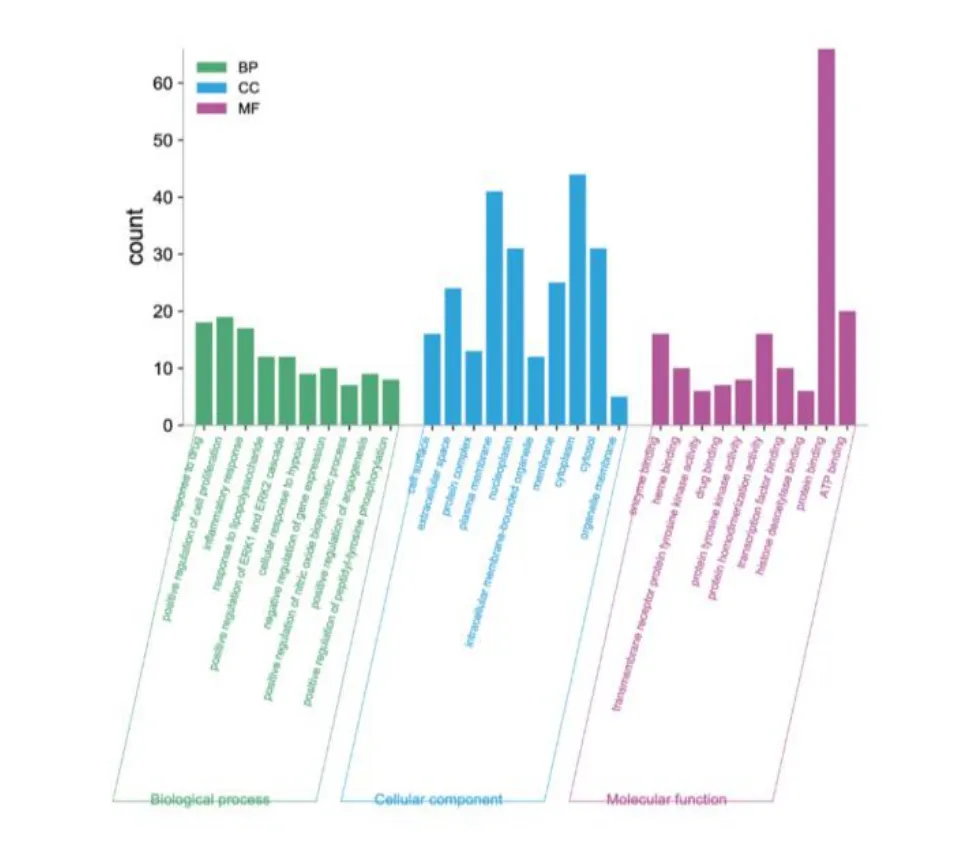
Figure 5 GO enrichment analysis of treating Tha targets.The database revealed the top ten enriched items in the BP, CC and MF categories.BP,biological process;CC,cell component;MF,molecular function.
Using David databases to analyze the KEGG pathway of 94 targets of DBD for the treatment of Tha.Based on the p-value, we selected the top 20 most enriched pathways and visualized them using the software (Figure 6).The top ranked pathways were Pathways in cancer, Acute myeloid leukemia,Complement and coagulation cascades, TNF signaling pathway, PI3K-Akt signaling pathway, Ras signaling pathway, and the cancer-associated pathways.
Molecular docking
Molecular docking analyzed three targets (HSP90AA1, IL-6, and HRAS)with the highest degree and 3 compounds (quercetin,3,9-di-O-methylnissolin and isoflavanone) obtained from the active components-targets network.The result showed that the binding energies of the three compounds and the corresponding target proteins were all less than−5.0, showing good docking ability and high binding activity (Figure 7).The binding energy of quercetin to HRAS was −8.7KJ·Mol-1and formed six hydrogen bonds with the amino acid residues LYS-16, GLY-60, VAL-29,GLU-31, SER-17 and ALA-18, which was the most stable activity ingredient.The binding energies of the various compounds are shown in Table 3.
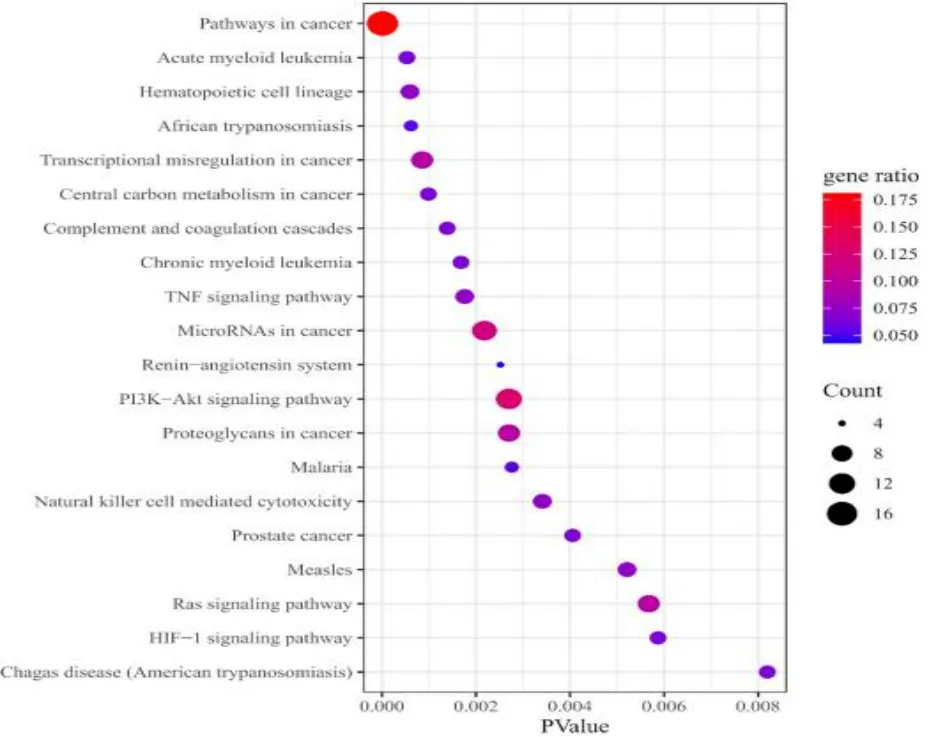
Figure 6 Analysis diagram of enrichment of the KEGG key target in the treatment of Tha.The abscissa is the P value, and the ordinate is the pathway name.Node color is displayed in a gradient from red to green in descending order of the gene ratio.The size of the nodes is arranged in ascending order of the number of genes.
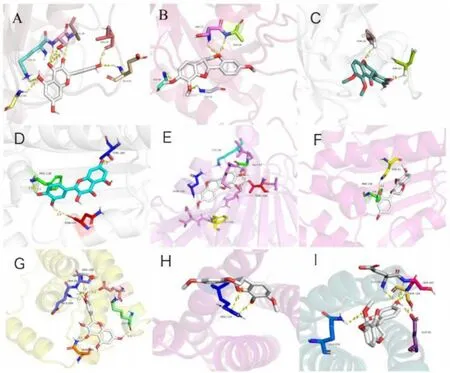
Figure 7 Molecular docking diagram of key compounds and target genes of DBD in the treatment of Tha.This figure indicated the molecular docking diagram of key compounds and target genes of DBD in the treatment of Tha.(A)HRAS-quercetin(B)HRAS-3,9-di-O-methylnissolin(C) HRAS-isoflavanone (D) HSP90AA1-quercetin.(E)HSP90AA1-3,9-di-O-methylnissolin (F) HSP90AA1-isoflavanone (G)IL-6-quercetin(H)IL-6-3,9-di-O-methylnissolin(I)IL-6-isoflavanone.

Table 3:Docking score of active compounds with key targets of DBD
Discussion
Based on the research method of network pharmacology, we predicted 19 active ingredients, 94 potential targets, 523 GO analysis, and 94 KEGG pathways of the DBD involved in the treatment of Tha.The common targets(HSP90AA1, IL6 and HRAS ) located at the core of the PPI network may play an important role in the treatment of Tha with DBD.The enrichment analysis showed that the key targets were mainly concentrated in PI3K-Akt signaling pathway,TNF signaling pathway and Ras signaling pathway.About molecular docking, the results show that the top 3 compounds can stably bind to the top 3 key targets.Meanwhile, Quercetin showed the best binding to the HRAS target.
From the research of this paper, the main active ingredients of DBD in the treatment of Tha are quercetin, isoflavone, 3,9-di-O-methylnisolin,among which quercetin has anti-inflammatory, antioxidant, hypotensive,hypolipidemic and immunomodulatory effects [11].Isoflavanone is a naturally derived phytoestrogen compound with many physiological activities such as eliminating oxygen free radicals, anti-oxidation and protecting the cardiovascular [12].But for 3,9-di-O-methylnissolin, there are few types of research at home and abroad.
The result of the PPI system analysis of the current study, HSP90AA1,IL6 and HRAS were recognized as the center genes.The main role of HSP90AA1 is to maintain protein homeostasis and cytoprotection [13].Recent studies have shown that heat shock(HS) increases HbF and γ-globin mRNA levels in differentiated primary human erythroid cells and affects γ-globin mRNA at nascent transcription and transcriptional stability,as well as other levels [14].Hsp90 Associates with Hb in Erythroid-Like Cells,Driving Globin Maturation During Erythropoiesis and Nonerythroid Cells[15].Huang Peng et al.suggested that Heme Regulated Inhibitor (HRI)might present a pharmacological target for raising fetal hemoglobin levels[16].And the activation of HRI is regulated by the HRI-Hsp90 complex and mediated by Hsp90 [17].IL6 is a pro-inflammatory factor involved in the process of the inflammatory response [18].Blood transfusion is the current gold standard for the treatment of beta-Tha, but iron overload secondary to blood transfusion can lead to a range of complications.The inflammatory cytokine interleukin (IL)-6 has been reported to upregulate hepcidin gene expression in monocytes [19].Hepcidin can regulate and stabilize the metabolic distribution of iron in the body.Insufficient hepcidin expression is thought to be responsible for the iron overload observed in β-Tha [20].Unfortunately,we have not been able to find literature on HRAS and Tha.
Based on the results of GO and KEGG pathway analysis, we believe that DBD can improve Tha in the following ways.From the GO enrichment analysis, it can be seen that the main biological process of DBD improving Tha involves the inflammatory response,TNF signaling pathway enriched by KEGG analysis is an important pathway of the inflammatory response [21],and the anti-inflammatory effects of quercetin may be mediated by modulating the TNF signaling pathway [22].The PI3K-AKT signaling pathway regulates basic cell functions, such as transcription, translation,proliferation, growth, and survival [23].A previous study demonstrated that thepPI3K/AKT pathway was revealed to be correlated with the progression of Tha.The regulation of the PI3K/AKT pathway is a potential therapeutic approach for β-tha, and its downstream target proteins-Forkhead transcription factors (FOXOs ) are key regulators of oxidative stress and erythrocyte maturation during erythropoiesis and are involved in terminal erythropoiesis [24].Besides, Efficient induction of fetal hemoglobin (HbF)production reduces complications of β-Tha.Bouscary found that the PI3K signaling pathway can induce HbF production and play an important role in the proliferation, differentiation and maturation of erythroid precursors [25].Recent studies have shown that Ras can promote hematopoietic cell proliferation or differentiation in a cell-specific manner, depending on the cell type and or maturation state in hematopoietic cells.Meanwhile, Fakher Rahim et al.have shown that activation of the RAS signaling pathway can effectively induce HbF[26].In Traditional Chinese Medicine theory,DBD is used for Invigorating Qi and Regenerating Blood and treating blood deficiency fever.Our analysis results suggest that DBD exactly has a basis to exert the traditional function of "Relieve inflammation and Regenerating blood".
There are still some limitations of this study.We only explored the mechanism of action of DBD in the treatment of Tha using network pharmacology.Further studies are needed to elucidate the exact mechanism.We will conduct more reliable experiments in animals and clinical, and further research to clarify the exact mechanism and provide more scientific evidence.
Conclusion
In conclusion, this study analyzed the mechanism of DBD improvement and treatment of Tha by network pharmacology and molecular docking.The results showed that the effects of DBD on Tha included increased expression of the γ-globin gene in erythrocytes, induction of HbF, and decreased inflammatory responses.Our findings may provide new directions for the clinical treatment of Tha.
